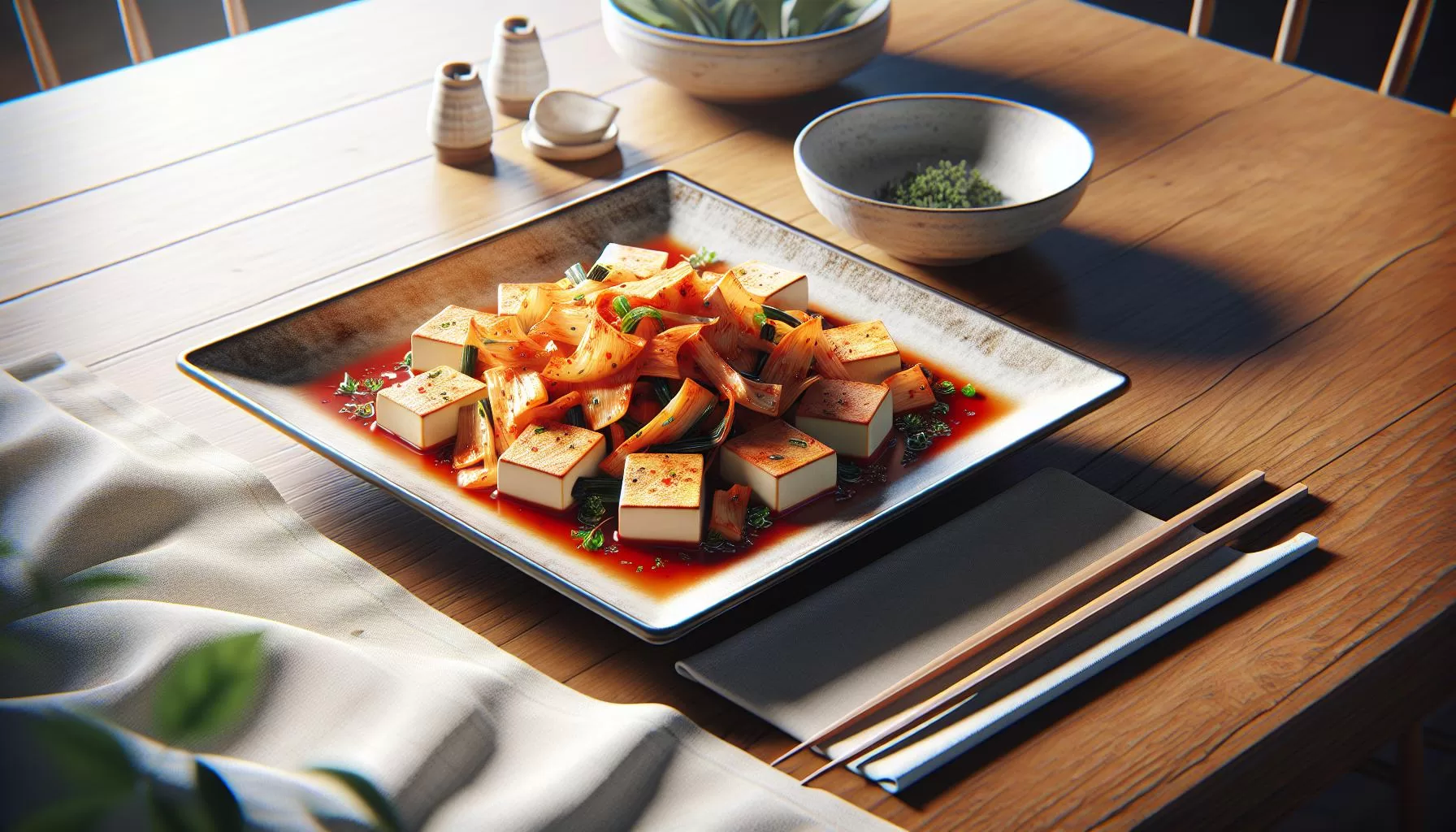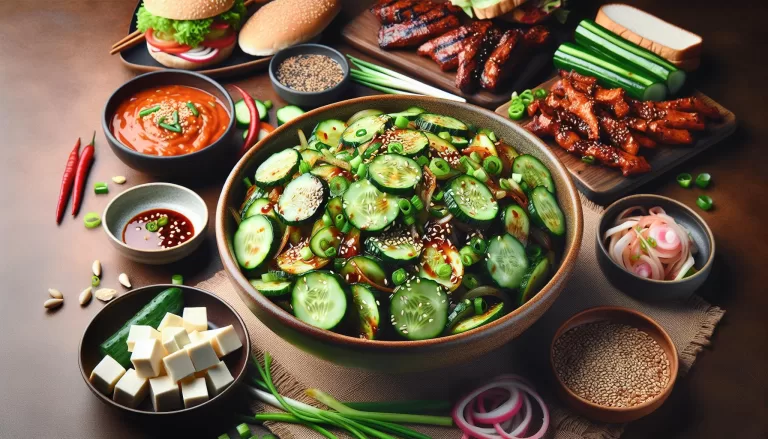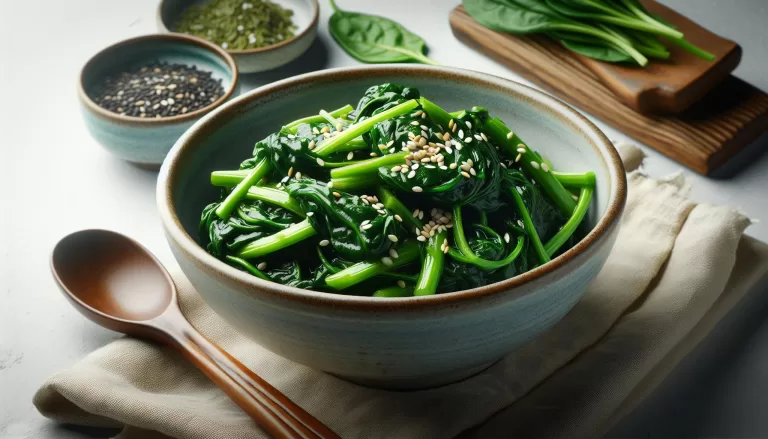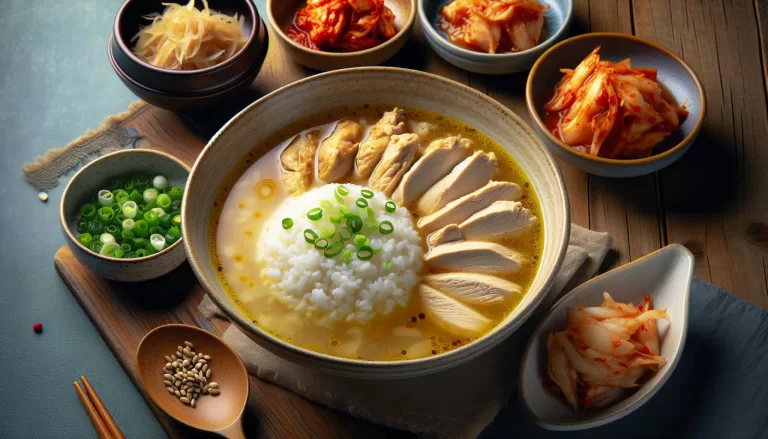Healthy Homemade Dubu Kimchi Tofu Recipe – Boost Your Nutrition with Stir Fried Kimchi

Ingredients for Homemade Dubu Kimchi Tofu
Making the Homemade Dubu Kimchi Tofu is an easy task. Your pantry and fridge would already have most of the ingredients. Here is a list of the main ingredients with their specific quantities:
| Ingredient | Quantity |
|---|---|
| Soft tofu (Dubu) | 1 block, about 14 ounces |
| Kimchi | 2 cups, aged, and roughly chopped |
| Pork belly | 1/2 cup, thinly sliced |
| Garlic | 2 cloves, minced |
| Korean chili pepper flakes (Gochugaru) | 1 tablespoon |
| Korean-style red pepper paste (Gochujang) | 2 tablespoons |
| Soy Sauce | 1 tablespoon |
| Sugar | 1 tablespoon |
| Sesame oil | 2 tablespoons |
Let’s talk about tofu, specifically Dubu. It’s the Korean term for tofu. However, any kind of soft tofu will work for this recipe. You’re free to choose based on your preferences and availability.
And then comes Kimchi. A well-aged spicy and tangy kimchi is perfect for this recipe. If you’re a fan of the extra tang, go for kimchi aged for at least two weeks.
The pork belly is optional, but it adds a rich flavor to the dish. Feel free to swap it with a plant-based protein if you’re skipping meat, or to cater to vegetarian or vegan guests. It’s your dish, make it your way!
You may not have Korean chili pepper flakes (Gochugaru) or red pepper paste (Gochujang). Don’t worry. Substitute it with a combination of paprika, cayenne pepper, and a little bit of sweetener like honey or sugar.
In this recipe, Soy Sauce and Sesame Oil add a flavorful depth! Remember, Soy sauce is not just a flavor enhancer. Not all soy sauces are created equal, so look for naturally brewed varieties.
But let’s not forget about the sugar! It balances the flavors and adds a bit of sweetness to the overall taste of the dish.
Step-by-Step Guide to Making Dubu Kimchi Tofu

Gathering your ingredients
First, make sure you’ve got all your ingredients on hand. Your soft tofu, kimchi, pork belly, garlic, chili pepper flakes, red pepper paste, soy sauce, sugar, and sesame oil should all be ready to go. Remember, you can sub the pork with a plant-based protein if you prefer. Don’t have the exact Korean chili pepper flakes or red pepper paste? Try their substitutes that you can find locally. Here’s the exact breakdown:
Ingredients
|
Quantity
|
Soft tofu
|
1 block
Well-aged kimchi
|
1 cup
Pork belly (or substitute)
|
200 grams
Fresh garlic
|
2 cloves
Korean chili pepper flakes
|
1 tablespoon
Red pepper paste
|
1 tablespoon
Soy sauce
|
2 tablespoons
Sugar
|
1 tablespoon
Sesame oil
|
1 tablespoon
Preparing the Kimchi Tofu
Let’s jump into the process now.
- Kick things off by preparing the tofu. You’ll want to cut it into bite-sized pieces and lightly pan-fry in a non-stick skillet. Ensure all sides are slightly golden and set aside.
- Next, prepare the stir-fry. Start by cooking the pork belly using a generous amount of the sesame oil until it’s well done.
- Following this, add in the garlic, chili pepper flakes, and your well-aged kimchi. Don’t skimp on the kimchi – it’s where this dish gets most of its flavor.
- Once the kimchi starts to soften and meld with the other ingredients, add in your red pepper paste.
- From here on in, it’s all about flavor balance. Introduce the soy sauce and sugar, and adjust to taste.
- And there you have it. Your stir-fry is ready to be served over your prepared tofu.
Nutritional Facts
Don’t forget – this dish isn’t just about flavor. It also provides nutritious values like protein, vitamins and more.
Ingredient
| Calories | Carbs | Protein |
Fat
| — | — | — |
Soft tofu
| 144 kcal | 4g | 15.7g |
8g
Pork belly
| 776 kcal | 0g |
Tips for Buying and Handling Tofu and Kimchi

You’re halfway to a delectable plate of Dubu Kimchi Tofu and what’s coming next is just as crucial. Let’s delve into tips for procuring and managing tofu and kimchi.
When buying tofu, choose freshly made tofu if possible. You’ll want it to have a smooth appearance and a uniform color. For this recipe, soft tofu is your best bet but you can substitute it with silken tofu for a creamier texture.
Storing tofu is an important consideration as well. Once opened, keep tofu in water and refrigerate. Change the water daily to extend its lifespan and boost taste consistency. If the tofu appears to be discolored or smells peculiar, it’s a good sign to discard it.
As for kimchi, go for well-ripened kimchi. Much like wine, kimchi gets tastier as it ages. Sniff out the tangy and sour smell – a sign of well-matured kimchi ready to be stir-fried.
Don’t fret if you’ve bought too much; kimchi is a wonder in maintaining its taste even if stored for an extended period. Simply keep it in the original jar, pressed down to let the vegetable stay under the brine. You’ll want to have it in the coldest part of your refrigerator.
Speaking of tumultuous flavors, an unconventional kick you could try is adding a dash of apple cider vinegar to your kimchi stir-fry. It’s one of those tips not everyone knows but it adds an extra tanginess to your dish.
Isn’t it fascinating how you can enhance cooking techniques with knowledge? Let’s put these to practice in the next part of the recipe. Of course, remember that there’s room for creativity in every kitchen; these are guidelines but your personal touch will make your Dubu Kimchi Tofu truly your own.
Serving Suggestions for Dubu Kimchi Tofu

Your plate of sizzling Dubu Kimchi Tofu is ready, stirring the senses with its tantalizing aroma and vibrant colors. Isn’t it time to enhance this flavorful journey and take your dining experience up a notch? Let’s delve into some serving tips to elevate the savory symphony of Dubu Kimchi Tofu.
Top off your Dubu Kimchi Tofu with a sunny-side-up egg. This extra layer of protein doesn’t just add richness, but also integrates a touch of creamy texture that balances the biting tang of the kimchi. Picture that yolk breaking and slowly pooling around your tofu and kimchi. It’s an experience indulgent enough to keep you coming back for more.
Surprised by the egg addition? Let’s take it a step further. How about complementing your dish with traditional Korean side dishes or banchan? Favorites like fermented soybean paste soup (Doenjang Guk), Korean potato salad (Gamja Salad), and cucumber kimchi (Oi Kimchi) pair superbly with Dubu Kimchi Tofu. These side dishes offer varied flavors and textures that will complement and elevate your main dish.
If you’re keen to maintain a healthier profile for your meal, why not accompany your serving of Dubu Kimchi Tofu with a refreshing Asian-style coleslaw? Not only does it offer a variety of nutrients but also supplies a refreshing crunch that counterbalances the spiciness of the kimchi. You can toss together some shredded cabbage, carrots, bell peppers, and heirloom radishes with a light sesame vinaigrette.
To round off, if your lifestyle is on the go, a Dubu Kimchi Tofu wrap or roll-up can be your perfect friend. Load it up with your tofu and kimchi, consider adding fresh or sautéed veggies of your choice – think spinach, bell peppers, sprouts. This portable version of your dish will offer a fun way to relish your meal without skipping a beat!
Who knew going the extra mile with Dubu Kimchi Tofu could be so exciting? Let your creativity take shape in your kitchen and leave your guests wanting more.
Health Benefits of Tofu and Kimchi

As you indulge in this delightful Dubu Kimchi Tofu dish, you’re not just treating your taste buds, but you’re also nourishing your body. The main ingredients, tofu and kimchi, bring a wealth of health benefits to the table.
Tofu, a soy-based product, is an excellent protein source, particularly for vegetarians or vegans. It’s low in calories yet rich in essential amino acids and minerals. Here are a few more benefits that you can get:
- Boosts heart health: Tofu can lower the level of low-density lipoprotein, the “bad” cholesterol.
- Bone health enhancement: Its high calcium and magnesium content fortify your bones.
- Supports weight loss: Being low in fat and high in protein, tofu aids in keeping you full and helps maintain a healthy weight.
On the other hand, kimchi is a fermented food, making it a natural source of probiotics. Probiotics support gut health, and a healthy gut can improve your immune system and moods. Kimchi also offers these advantages:
- Promotes digestion: The presence of lactobacilli bacteria aids in digesting your food better.
- Antioxidant-rich: It carries a high dose of antioxidants that combat harmful free radicals in your body.
- Vitamin-packed: It’s an excellent source of essential vitamins including vitamin A, B, and C.
| Benefits | Tofu | Kimchi |
|---|---|---|
| Protein-rich | Yes | No |
| Low-calorie | Yes | Yes |
| Heart-healthy | Yes | Yes |
| Supports digestion | No | Yes |
| Enhances bone health | Yes | No |
| Antioxidant-rich | No | Yes |
| Vitamin-packed | No | Yes |
So, take delight knowing your Dubu Kimchi Tofu dish isn’t just tasty – it’s incredibly nutritious too! As with any food, moderation is key. Pair it with a balanced diet and an active lifestyle to maximize its benefits.
Conclusion
You’ve now discovered the amazing health benefits packed into every bite of Dubu Kimchi Tofu. It’s clear that this dish isn’t just delicious, but it’s also a powerhouse of nutrition. With tofu’s protein content and heart-healthy properties, coupled with the gut-friendly probiotics and antioxidants in kimchi, you’re doing your body a favor every time you enjoy this meal. But remember, balance is key. Pair this dish with a well-rounded diet and regular exercise to truly unlock its potential. So, why wait? Get into your kitchen and whip up some homemade Dubu Kimchi Tofu today. Your taste buds and your body will thank you.





